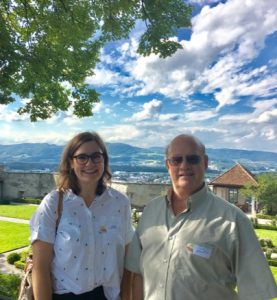16 September 2019–Earthquake faults have short memories—or at least, that’s what the traditional earthquake cycle model suggests.
Based on the elastic rebound theory proposed by Harry Fielding Reid after the 1906 San Francisco earthquake, the traditional model assumes that each earthquake in an area occurs independently of one another, and that the average time between earthquakes (and standard deviation from that average) doesn’t change over time.

Under this theory, “the probability of an earthquake increases with time until one occurs, in line with the idea of steady plate motion and strain accumulation proposed by Reid,” says Leah Salditch, a fourth-year Ph.D. student at Northwestern University. Assuming that earthquakes are independent “statistically requires that the probability of an earthquake drop to zero after one occurs. This means that the probability history leading up to that earthquake is completely erased after each earthquake, and consequently that all built-up strain is completely released. The probability of the next earthquake then depends only on the time since the last one, so we say it has ‘short-term memory.’”
However, paleoseismic records across the world—including notably in California—often show large earthquakes clustering together in time, followed by long quiet periods. “This led me to try and understand how these clusters fit in to our understanding of the seismic cycle model and earthquake hazards,” says Salditch.
Salditch and her colleagues are working on a Long-Term Fault Memory Model, where the probability of a large earthquake is reflective of the accumulated strain on a fault, rather than the elapsed time between earthquakes. “The probability increases with accumulated strain—and time—until an earthquake happens, after which it decreases, but not necessarily to zero,” Salditch explains. “Hence, the probability of an earthquake can depend on the earthquake history over multiple prior cycles.”
In simulations from plate boundaries and intraplate areas, the Long-Term Fault Memory Model “can create earthquake histories both with and without clusters,” she says. Salditch received a 2017 SSA Student Presentation Award for her presentation on the model at the SSA Annual Meeting in Denver.
Her career interests began with childhood summers spent in the Texas Hill Country on Lake LBJ. “The Llano uplift of Precambrian granite and the pyrite-laden sand lake shores were truly magical to me as a child—pink granite and sparkly beaches—need I say more?” jokes Salditch.
But she was also intrigued by the human history of the area, where her German ancestors were one of the few groups known to have peaceful interactions with local Comanche tribes. As an undergraduate she studied cultural anthropology at American University, taking a last-year archaeology course “on a whim,” she says. “I was inspired by the ability of archaeologists to tell stories that may otherwise go untold. The field’s mixture of exploration and social justice had me hooked.”
Working in cultural resource management after graduation, one of Salditch’s jobs was to help civil engineering projects comply with federal and state preservation laws, where cultural sites could be at risk from projects like interstate highway expansion and new transmission lines. “It was through this fieldwork that I was introduced to consulting geologists, and in particular geomorphologists. I found their ability to read the landscape fascinating,” she recalls.
Her interest in geosciences and career opportunities in that field led her back to school for a master’s degree at University of Texas at Dallas. “This was right around the time that induced seismicity was becoming a huge public policy issue in North Texas,” says Salditch. “Residents were very familiar with the oil and gas industry, but completely unfamiliar with earthquakes, myself included.”

Salditch switched her interest from geomorphology to seismology, working on her Ph.D. with advisor Seth Stein and an M.S. in statistics with Bruce Spencer. “If there is one thing I have learned in graduate school,” she says, “it is that collaboration is the key to good science.” Her seismic hazard map research led her to USGS researcher Susan Hough’s work on historical earthquake intensities, opening the door for a joint database endeavor between the USGS and Northwestern called the California Historic Intensity Mapping Project, or CHIMP. The CHIMP database collects data on the distribution of historical and modern earthquake intensities to help evaluate current probabilistic seismic hazard assessments.
She has received a SSA Global Travel Grant to attend the 7th edition of the International Colloquium on Historical Earthquakes & Paleoseismology studies in Barcelona, Spain this November. “I will present my work on CHIMP here and discuss with international colleagues about how they are carrying out their own historical seismic intensity databases in their countries,” says Salditch.
Salditch hasn’t settled on her next step after graduate school. “There are so many directions my career could go – academia, researching at a government institution, hazard modeling in the insurance industry, hazard communication and emergency response for local governments, seismic engineering consulting, the list goes on,” she says. “Most people in my generation change jobs and even industries several times–I have once already–so right now, I am keeping my options open to all opportunities that present themselves.”
SSA At Work is a monthly column that follows the careers of SSA members. For the full list of issues, head to our At Work page.
